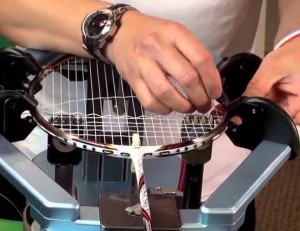 Players often ask: “Why do basement stringers charge less than store stringers?”
Players often ask: “Why do basement stringers charge less than store stringers?”
The simple answer is options.
Basement stringing customers save money because basement racquet stringers offer fewer options. Basement stringers can stack up a bunch of discount stringing racquets for five or six days and then bang them all out at the same time without having to stop and reset custom machine tension and custom string options like custom racquet stringers do.
Custom racquet stringers, by contrast, offer many options. They typically carry a large inventory of string and can offer many more precision tension options than basement stringers with budget machines.
Every racquet they string takes more time. It is a more careful and deliberate process. Professional racquet technicians don’t just bang out custom string jobs. They are required to stop and check the custom spec sheet before starting every racquet.
Then…
They strip the racquet of all string and head tape. They clean the frame, remove all tape residue and inspect it. They check to see if any grommets are missing and formulate a repair plan. Often, at this point, they have to stop and call the customer to consult with them about how they want their grommets repaired.
Once they have mapped out the road ahead, including repairs, they set up the string and the tension on the machine and start weaving. When they are done weaving and repairing, they have another stringer verify the weave and the repairs to ensure that everything is perfect. If any flaws are found in the weave or the repairs, they back up and correct everything before tying off.
Once the racquet is done, they enter the notes in the customer file and notify the customer by email. All of this takes time and expertise, but it guarantees that they meet customer specifications exactly.
Finally, convenience is a major factor in stringing costs. Basement stringers often have very limited hours. Customers have very narrow windows during which they can pick up or drop off their racquets while store stringers are open long hours. As a result, pick up and drop off are generally more convenient with store stringers than with basement stringers.
In short, store stringing is a professional stringing service with a premium price while basement stringing offers fewer options at a lower price. Here in Calgary, Racquet Network offers both stringing options to their customers.
Racquet Network’s Custom Stringing vs Discount Stringing Table
| CUSTOM | DISCOUNT | |
|---|---|---|
| String options | Choose from all strings | None |
| Colour options | Choose from all colours | None |
| Tension options | Choose from full range | None |
| Grommet repairs | Minor repairs included free | None |
| Head tape removal | Included free | None |
| Frame cleaning | Included free | None |
| Service Options |
|
|
| Turnaround options |
|
|
| Notifications | By email | None |
| Early pickup options | Permitted | Not permitted |
| Warranty options | Two weeks (labour only) | None |
| Sponsorship credits | Automatic with online orders | None |
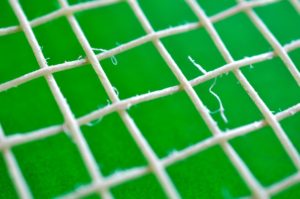
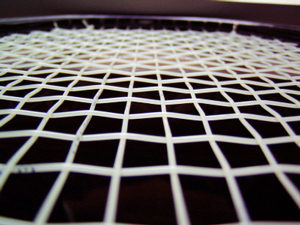 As professional stringers, we spend several hours each week fixing problems created by amateurs. Most of the time, these errors are minor and can be fixed relatively quickly. Sometimes, however, the mistakes are fatal to life of the racquet and sometimes, sadly, the racquet breaks or cracks before we can fix it.
As professional stringers, we spend several hours each week fixing problems created by amateurs. Most of the time, these errors are minor and can be fixed relatively quickly. Sometimes, however, the mistakes are fatal to life of the racquet and sometimes, sadly, the racquet breaks or cracks before we can fix it.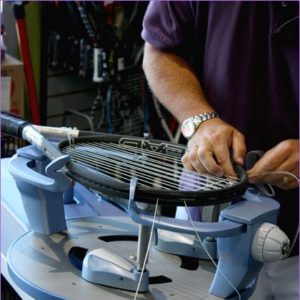 You see them everywhere, little signs cable-tied to tennis court fences or pinned to bulletin boards offering dirt cheap stringing. You see them on Craig’s List, Kijiji and a thousand other websites.
You see them everywhere, little signs cable-tied to tennis court fences or pinned to bulletin boards offering dirt cheap stringing. You see them on Craig’s List, Kijiji and a thousand other websites.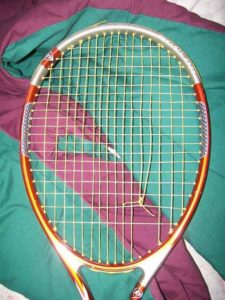 Here is a question we get asked all of the time: pros hit harder than I do, so why don’t I ever see them break their strings?
Here is a question we get asked all of the time: pros hit harder than I do, so why don’t I ever see them break their strings?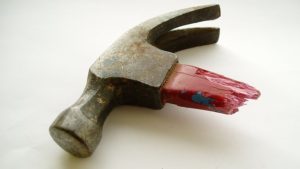 Even hammers break. Strong as the they are, they will all break eventually. So it shouldn’t surprise anyone that racquet strings break too.
Even hammers break. Strong as the they are, they will all break eventually. So it shouldn’t surprise anyone that racquet strings break too.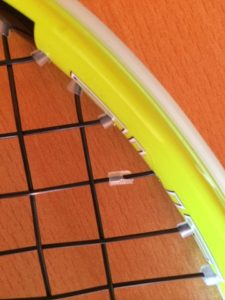 Step Two in preserving the life of your strings is to take care of your frame. Split or broken grommets are string eaters. When they are whole, they work to prevent the string from touching the sharp edges of the graphite. When they split or break, the graphite cuts through the string like a hot knife through butter.
Step Two in preserving the life of your strings is to take care of your frame. Split or broken grommets are string eaters. When they are whole, they work to prevent the string from touching the sharp edges of the graphite. When they split or break, the graphite cuts through the string like a hot knife through butter.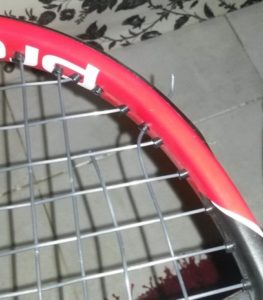 Imagine a brand new tennis racquet equipped with perfectly installed and completely flawless new string. Nobody has ever used this racquet before. Now imagine a recreational tennis player (or a total pro — it doesn’t really matter which) tossing a regular ball into the air and hitting it for the very first time with this brand new racquet.
Imagine a brand new tennis racquet equipped with perfectly installed and completely flawless new string. Nobody has ever used this racquet before. Now imagine a recreational tennis player (or a total pro — it doesn’t really matter which) tossing a regular ball into the air and hitting it for the very first time with this brand new racquet.